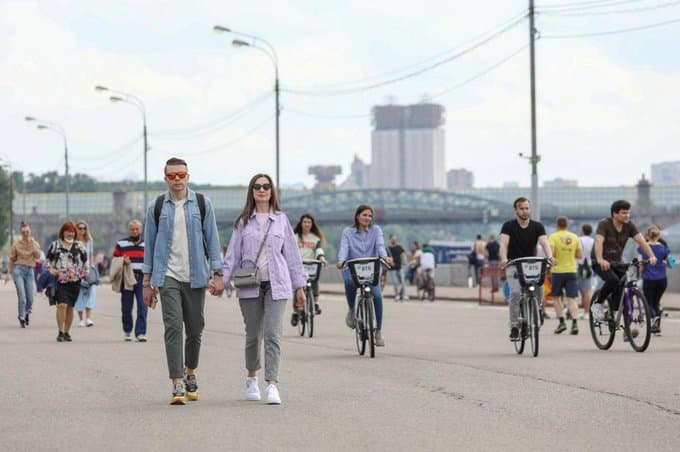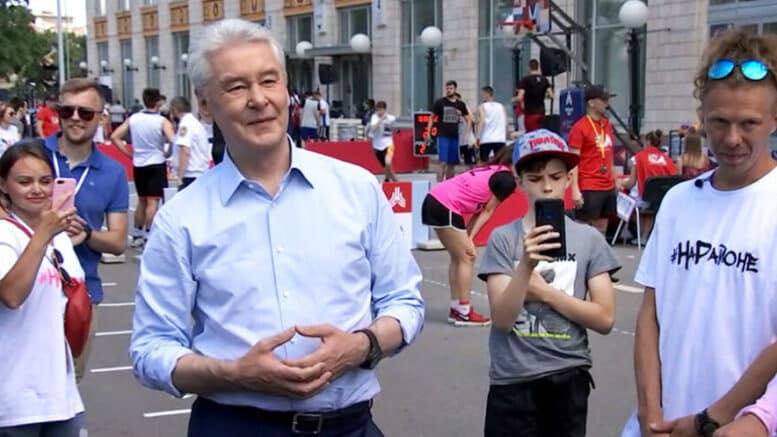As of Tuesday, June 23rd, after nearly three months of quarantine measures, Moscow has reopened. The city was able to mobilize phenomenal resources and put into place quite advanced policies. At the same time, several serious missteps undermined those efforts.
Moscow’s Experience
Overall, Russia’s experience with containing the virus has been quite successful. Russia is near the top of world charts in terms of positive cases for COVID-19, but most cases are asymptomatic and are the result of a large population with access to free, subsidized, or relatively inexpensive testing.
Much has been written of Russia’s potentially unreported COVID deaths. However, even at the highest estimations, such as the New York Times calculating 75% under reported, or even claims by some in Russia’s political opposition that deaths may be three times higher, this would still put Moscow’s deaths-per-million at under half that experienced by New York.
Although this strikes some as questionable, similar experiences have been reported in several countries in Eastern and Central Europe, in both countries considered “democratic” and those considered “authoritarian.” Reasoning behind the low numbers is sometimes given to early lockdowns, lower international tourism rates, or, perhaps most convincingly, to the use a particular tuberculosis vaccine which may have given the population at least partial immunity.

Moscow’s Gorky Park reopens on week two of the phased reoppening. Photo shared on Twitter by Reuters (@Reuters) June 16, 2020
Moscow’s Policies: Steps and Missteps
Moscow’s measures were pioneering, but not always well implemented. Most impressive was the rapid construction of a new infectious disease hospital in just six weeks – using, in part, military construction equipment, materials, and labor. The city also commendably rapidly built up testing capacity by building a new lab and networking private and state labs.
Some policies were announced as stricter than actually implemented. Moscow’s “lockdown,” for instance was largely unenforced at the pedestrian level. The mayor, in fact, announced when the rules were adopted, that those applying to foot traffic would not be enforced so long as the population was acting “within reason.” Admonitions to remain indoors were thus regarded by the population as recommendations. Many ignored them with impunity.
The city seemed to recognize that it policing such policies in Europe’s largest city would require major outlays of financial and political capital. While infections and mortality were fairly low, it made sense to keep the policy close to the hip but not fully deploy it. If such a policy were needed, however, soldiers and military equipment were brought in and based just outside the city. They were (thankfully) never called in, and the “rules” simply served to discourage mobility.
The city’s QR code system for vehicular traffic was implemented similarly. Codes delivered via the city’s website were tracked by Moscow’s network of traffic cameras that read license numbers, compared them to the QR database and automatically issued fines to those without the codes. However, the city approved every valid application for a QR code, which led to questions as to why the system was needed at all.
Again, having the system in place, to use more restrictively should it be needed, did make sense as a precautionary measure. It also discouraged some mobility and thus did serve a small effective purpose. However, without the eventual proven need for it, it seemed that the system had been applied largely for aesthetics, simply to prove that the city could implement such a system.
The QR codes for public transport and for traffic into and out of Moscow proved more directly problematic. Despite the city’s technical prowess and what seemed like the obvious choice to enforce rules by tying them to the traffic cameras or by blocking electronic public transport passes that lacked a corresponding QR code, the city initially attempted manual checks at metro stations and city entry points. The predictable results were massive traffic jams and crowds at metro stations creating potentially dangerous transmission points. After public outcry, the city quickly announced that electronic systems would be deployed. However, the irony that the city had created PR-disasters out of policies implemented apparently largely for their optics, was a blow to the city’s credibility.
The worst blunder, however, was the quarantine app. Again, the theory here was solid. While the city could afford to allow most citizens more freedom, those who had tested positive had to be effectively removed from the population. Removing them to their own apartments should have meant a more comfortable quarantine for the patient, a less expensive quarantine for the city, and a safer quarantine for all by not congregating all the infected into several potentially overcrowded facilities.
The app allowed the city to see the user’s location at all times and automatically issued fines to those who left their apartments. However, the hastily assembled app couldn’t account for occasional – and not uncommon – GPS glitches, which might put the user on the other side of the street, for instance, before recalibrating several minutes later. This resulted in tens of thousands of undeserved fines of around $75 a piece.
That the city refused to admit any fault with the app only made the situation worse. Some, to at least partially protect themselves, made use of what the city’s offer to supply a smart phone to use with the program. The city had intended this to be used by anyone who did not have one themselves, but many asked for the phone so as not to have to install the untrusted app on their own phones and, perhaps most importantly, to avoid commonly reported problems in installing the app, which could also result in fines, and also to delay having to use the app for 2-3 days until the phone was delivered. This added considerable expense to the city’s program.
The app additionally tarnished what should have been Moscow’s most progressive anti-COVID policy: a free city-wide antibody testing program. This should have theoretically allowed all citizens to discover if they had immunity or not and for the authorities to track true infection rates and trajectories. However, soon after the first randomly-invited citizens were tested, several were told that they had active antibodies, indicating that they could be infectious, and were ordered to install and use the infamous app. Enthusiasm for the testing program immediately dropped. So many declined their random invitations that the city was forced to make an early switch to open testing to any volunteers, but even then struggled to keep its target numbers for testing.
The follow-up procedure for those placed on quarantine was also poorly implemented. Russia requires two positive tests to count a patient as COVID positive, but because the patient is quarantined after the first, the follow up test is done at home. Many extra hands were brought in to maintain the system, and many of these new recruits running the tests were not properly trained in how to take them or even how to wear personal protective gear. The result was unprofessional service and often inconclusive tests requiring third tests, again at home, adding even more cost, inefficiency, and inconvenience to the program.
Moscow’s Reopening
Reopening has been similarly rocky. The mayor maintained a hardline, insisting that the city would remain closed until new cases per day were below, perhaps, one hundred right up to the day before announcing a three-week phased plan that would have the city fully reopened just in time for a Victory Day parade, apparently after being pressured by the federal authorities to do so. The result was something that felt hurried and arbitrary.
The reopening schedule for businesses and organizations was kept faithfully, on pain of fines. However, citizens rapidly stopped observing quarantine rules en massse. For instance, neighborhood playgrounds were not to be reopened until week three, but residents tore the tape down from many on day one of week one. Although workers put the tape up again each morning, it would be down again by midday, and became a favorite toy of many of the children playing there.
Moscow’s mask regime also rapidly deteriorated. It had never been evenly applied – with some grocery stores posting notices that masks were “recommended” while others tried to enforce them on admittance or even deny service at the checkout counter for non-compliant customers. This led to not-uncommon confrontations between employees and customers. However, before the reopening plan was announced, unmasked customers (or at least customers not openly carrying masks) were a small minority. After the reopening plan was announced, these percentages reversed, with the masked customers falling into the minority.
The most common place to find masks now is the subway. Before the reopening was announced, the majority of passengers were traveling with masks. Today, however, although still technically required on all public transport, about half of all passengers carry them. Perhaps half of those with masks properly wear them, while others have them pulled under their noses or even chins.
The mask regime was actively resisted from the beginning by some – particularly by those within the political opposition. Many argued that, if the government required the masks, that they should be provided for free. Others argued that the government could not require them because there was no mention of masks in the constitution or federal law. Observance of the regulation gradually dropped, especially after the reopening plan was announced. This escalated as more people stopped wearing them and it became apparent that the regime was not being enforced.
Most businesses and restaurants in the center are now reopen. A small minority (a single digit percentage, at best), are still dark and apparently will remain so. Business appears to be light, with outdoor seating preferred and entrance policies diverse. Some require masks, some have notices posted asking for them, and a few are taking temperatures at the door. There seems to be no coordination or set standards.
Political Futures
Moscow Mayor Sergei Sobyanin, whose star was rising quickly at the beginning of the pandemic as he quickly took charge of Moscow’s and, it seemed, Russia’s response to it, is now no longer seen on the major federal channels. Formerly a common fixture there as he led major infrastructure and investment initiatives before the pandemic, he seems to have lost much of his political capital.
In fact, public opinion of the pandemic response can probably be best seen in Mr. Sobayanin’s poll numbers, as he has gone from having approval ratings in the 70s just a year ago, to having those reduced to disapproval ratings in 70s today. Once considered a top contender to potentially replace Putin, his removal from office now seems not unlikely unless he can find a way to quickly rebound.
While some of this came from the fact that Moscow perhaps over prepared for crisis levels that never fully arrived, much more of this came from programs that were overzealously but ineffectively implemented. The mayor’s falling approval ratings could be seen mirrored in the streets as citizens took his measures less and less seriously. Moscow has certainly survived the pandemic, but its administration may have not.



